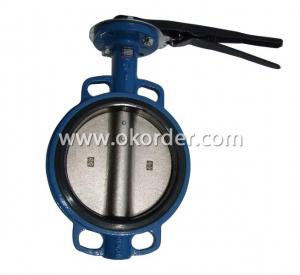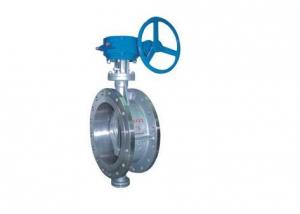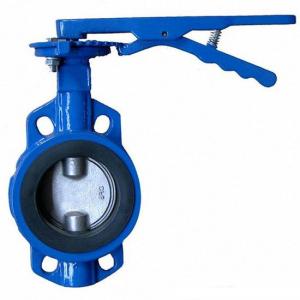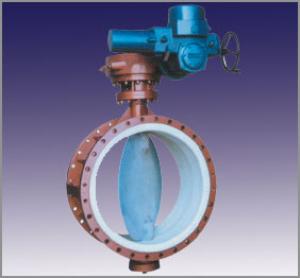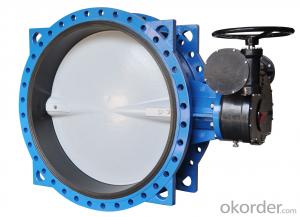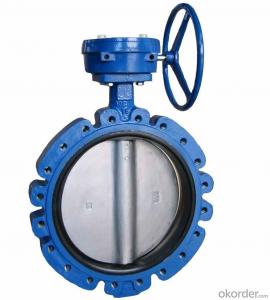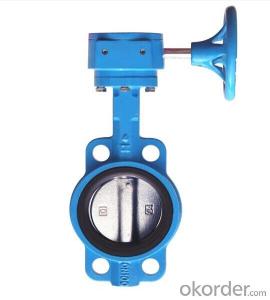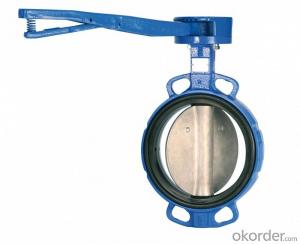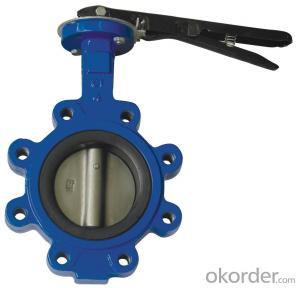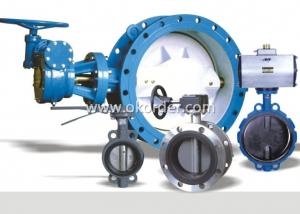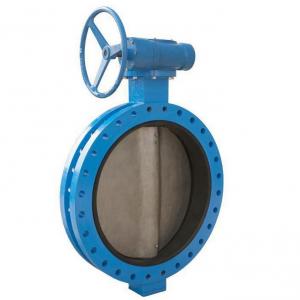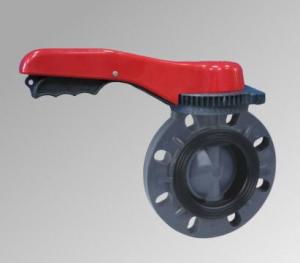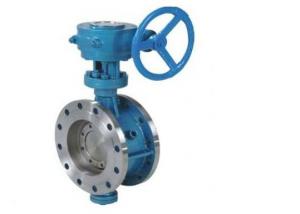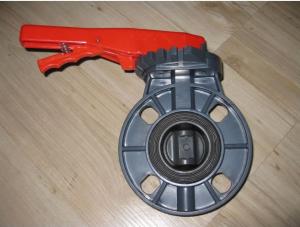Butterfly Valve DN250 Turbine Type BS Standard Low Price
- Loading Port:
- Tianjin
- Payment Terms:
- TT OR LC
- Min Order Qty:
- 50 pc
- Supply Capability:
- 5000 pc/month
OKorder Service Pledge
OKorder Financial Service
You Might Also Like
1. Manual Wafer Butterfly Valve Description:
A butterfly valve is a valve which can be used for isolating or regulating flow. The closing mechanism takes the form of a disk. Operation is similar to that of a ball valve, which allows for quick shut off. Butterfly valves are generally favored because they are lower in cost to other valve designs as well as being lighter in weight, meaning less support is required. The disc is positioned in the center of the pipe, passing through the disc is a rod connected to an actuator on the outside of the valve. Rotating the actuator turns the disc either parallel or perpendicular to the flow. Unlike a ball valve, the disc is always present within the flow, therefore a pressure drop is always induced in the flow, regardless of valve position.
2.Main Features of the Manual Wafer Butterfly Valve
a)Cast hole. Flange connection meet ANSI 125/150# DIN PN10/16 BS4504 PN10/16 in the meanwhile.
b)Soft seat. Replaceable. Increase of service life.
c)Double half shaft without pin.
d) Square and short neck. Easy to stick scutcheon and cost saving.
3. Manual Wafer Butterfly Valve Images:
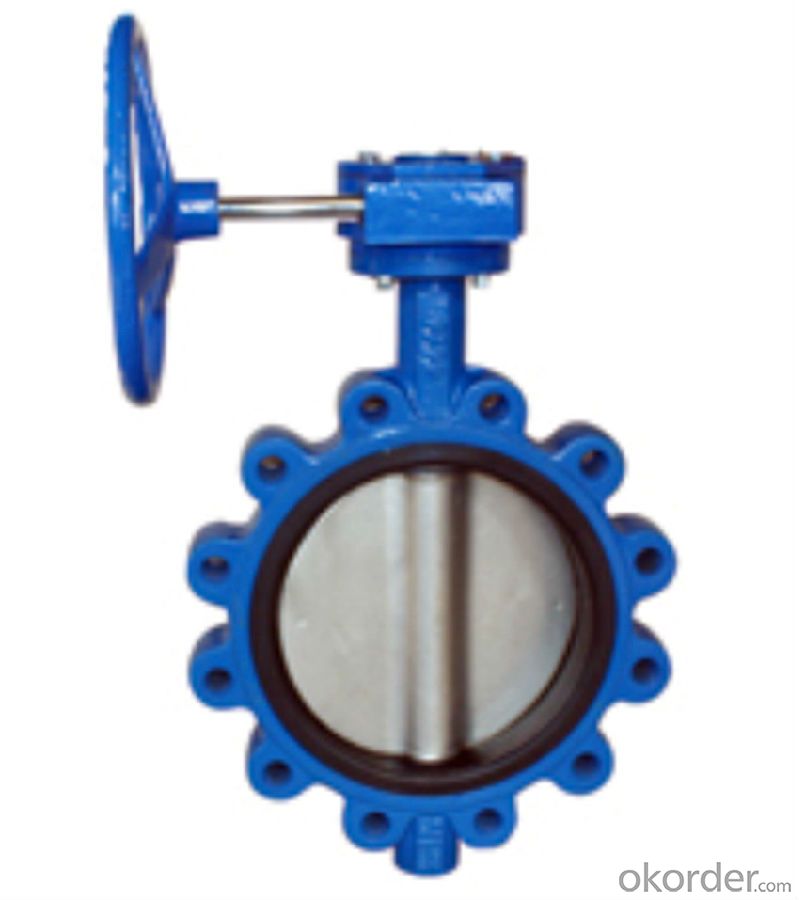
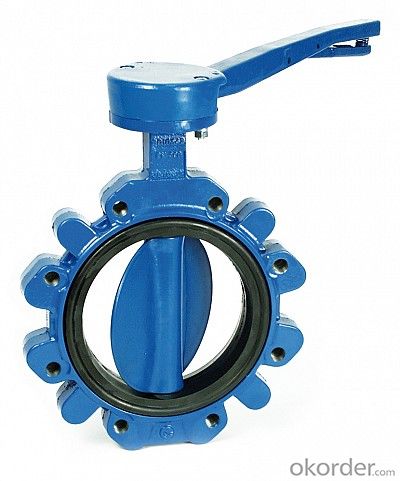
4.Manual Wafer Butterfly Valve Specification:
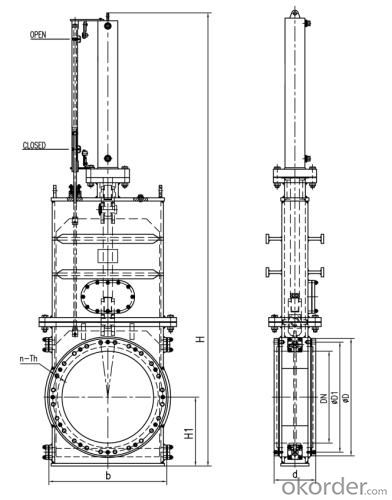
1)Size: DN40-DN1400
2)Material:body-CI/DI/WCB/SS
disc:DI/CF8/CF8M/C95400
3)Professional Maufacturer for more than 10 years
PRESENTATION:
1) Sizes:
DN40mm-DN1400mm
2) Materials:
a) Body: CI(cast iron ,GG25 )/ DI (ductile iron ,GGG40)
b) Disc: DI / CF8 / CF8M / C95400
c) Seat: EPDM / NBR / TEFLON / VITON
5.FAQ
1. What is manual wafer butterfly valve?
A: Wafer style is the more common of the two and is less expensive than the lug style. The wafer style butterfly valve is just about the standard. It ís so common that no one even bothers to use the word "wafer" when ordering a butterfly valve. It is taken for granted that if a butterfly valve is ordered, a wafer style will be received.
2. How about the Installation of the Wafer Style Butterfly Valve?
A: Butterfly valves are installed by inserting the valve between two flanges using bolts or studs and nuts to hold it all together. This type of installation, of course, makes it impossible to disconnect just one side of the piping system from the valve. That benefit is received using the lug style valve.
3. What is the working principle of manual wafer butterfly valve?
A: A butterfly valve is from a family of valves called quarter-turn valves. In operation, the valve is fully open or closed when the disc is rotated a quarter turn. The "butterfly" is a metal disc mounted on a rod. When the valve is closed, the disc is turned so that it completely blocks off the passageway. When the valve is fully open, the disc is rotated a quarter turn so that it allows an almost unrestricted passage of the fluid. The valve may also be opened incrementally to throttle flow.
- Q: What's the difference between a butterfly valve and an eccentric butterfly valve? What is the difference in field applications?
- Avoid friction and wear on the sealing surface!And, at the time of closing, and opening the opposite, there is a better sealing effect! Now generally use eccentric butterfly valve as the main. That's all I know! If there is any mistake, please forgive me!
- Q: Check valve; flexible joint `; installation order of electric butterfly valve
- It is better to make an elastic hanger.In order to prevent the generation of water hammer when the pump stops the damage to the rubber head, should be immediately set rubber head pump outlet, the gate valve and the check valve is not a very convincing reason to decide the order, custom order rubber head, check valve, electric butterfly valve.
- Q: The flow ratio of area and maximum flow area of the valve is? If it refers to the opening of the valve rotation angle? Butterfly linear closure refers to the butterfly valve at constant angular velocity close? When the change trend of flow is what? These valves problem bothering me for a long time,
- Butterfly valve headstock is a disc shaped disc, in the valve body around its own axis rotation, so as to achieve the opening or closing or adjustment; actuators have electric or pneumatic, and so on, through the transmission device to drive the stem, valve plate rotation;
- Q: Seat has said to the previous owner that the car needs a new air mass meter and dump valve.I am putting a new air mass meter on it.Does it have a dump valve.I know very little on this subject.
- every turbo will have a dump valve(waste gate) to regulate the boost to the engine Dump valves are fitted to the engines of turbo charged cars and sit between the turbo outlet and the throttle body. When transitioning from a boosted state to a closed throttle state (as in between shifts), due to inertia, the turbo continues to pressurize air, but the closed throttle prevents the compressed air from entering the engine. In this case the pressure exceeds the preset spring pressure in the dump valve and the excess pressure is bled off to atmosphere. Even with a dump valve the compressed air acts as a brake on the turbo (slowing it down), because the pressure on the backside of the turbo is at a higher pressure than on the front side (and the air actually wants to flow through the turbo backwards). A blowoff valve is a more elegant solution to this problem by allowing the turbo to freewheel when the throttle is closed (equalizing the pressure on both sides of the turbo). Unlike a dump valve a blowoff valve can be used at multiple boost settings without reconfiguration. Blowoff valves are sometimes incorrectly called dump valves because they serve a similar function, but they are very different solutions to the same problem.
- Q: How warm is the PTFE butterfly valve?
- The normal temperature can be kept at 120 degrees and the instant temperature is 150
- Q: What are the classification criteria for pneumatic butterfly valves?
- The channel of the valve body inner surface smooth, fluid resistance, high CV value, strong circulation, moderate torque, the use of four seal structure and elastic rubber gasket seat with SI in high temperature aging on the outside sealing surface, zero leakage medium.Pneumatic butterfly, characteristics, there is a slit leaving the valve seat, the product is suitable for use in poor air circulation environment.The pneumatic telescopic butterfly valve is characterized in that the novel and reasonable design, unique structure, light weight, convenient operation, open and close rapidly; in addition to the telescopic valve for regulating and throttling effect, compensation pipeline temperature generated by thermal expansion and contraction function, but also for the installation of valve replacement and maintenance convenience. The sealing parts can be adjusted, replaced, sealed, reliable and so on.
- Q: Where are the exhaust valves, mud valves and butterfly valves?
- The exhaust valve is suitable for the pipeline with working medium, so as to improve the efficiency of the water conveyance equipment and protect the pipe from deformation and rupture. Sludge discharge valves are suitable for use in floating waste water treatment plants, such as gypsum. Slag, scale power stations, smelters, sugar mills.
- Q: What do you mean by manual butterfly valve DN100 D341X-10?
- DN100 refers to the inside diameter of the butterfly valveD stands for butterfly valves3 represents the turbine drive4 represents the flange connectionThe 1 represents straight throughX is the representative of the Dengqen rubber seal10 represents the pressure of 1.0Mpa (10 kg)Manual butterfly valve, also known as turn over plate valve, is a simple structure of the control valve, but also can be used for low pressure pipe medium switch control. Butterfly valve refers to the closure of parts (valve or butterfly plate) as the disk, around the valve shaft to achieve rotation and closing of a valve, the main cut off on the pipe and throttling role. Butterfly valve headstock is a disc shaped disc, in the valve body around its own axis of rotation, so as to achieve the purpose of opening or closing or regulation. Butterfly valve used in furnace, coal gas, natural gas, liquefied petroleum gas, city gas, hot and cold air, chemical smelting and power generation environmental protection engineering system, conveying a variety of corrosive and non corrosive media pipeline, used to adjust and cut off the media flow.
- Q: What is the meaning of American Standard butterfly valve B series
- American Standard flange connection is divided into A, B series. A series for normal flanges, B series for compact flanges. 24 "to no AB series, flange standards for B16.5, 24" above B16.47.
- Q: Butterfly valve D71X-16 and D71X-16Q what is the difference?
- The two difference is that the body of the material is not the same, 16 behind with no sign, expressed as a default, is carbon steel (usually C), if you need to specify material, just behind with symbols, such as Q nodular cast iron, stainless steel P.
Send your message to us
Butterfly Valve DN250 Turbine Type BS Standard Low Price
- Loading Port:
- Tianjin
- Payment Terms:
- TT OR LC
- Min Order Qty:
- 50 pc
- Supply Capability:
- 5000 pc/month
OKorder Service Pledge
OKorder Financial Service
Similar products
Hot products
Hot Searches
Related keywords







